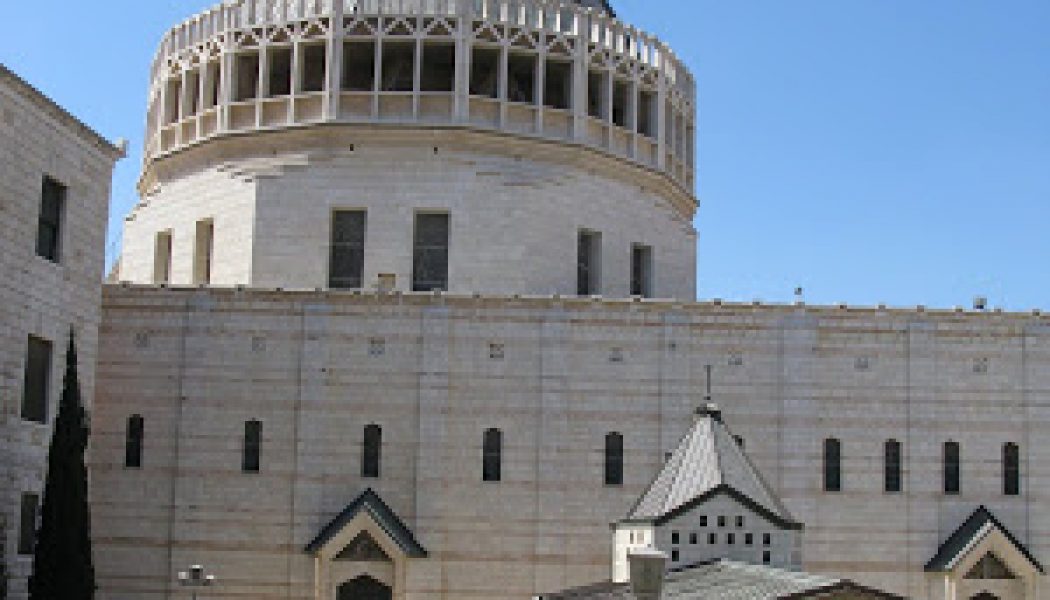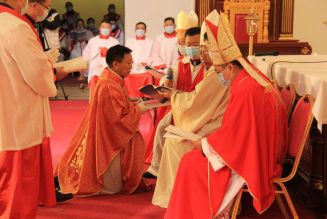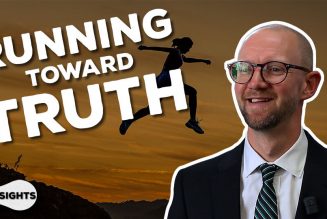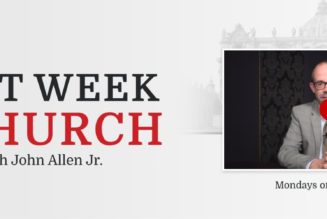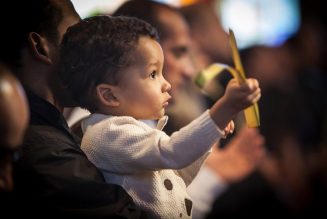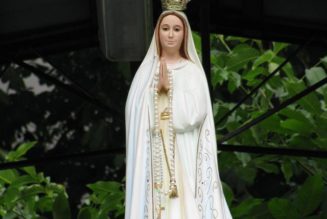 |
| Basilica of the Annunciation in Nazareth, Israel |
The Readings for this Sunday
remind me of the Basilica of the Annunciation in Nazareth, which I’ve had the
privilege of visiting a couple of times.
This beautiful church is built on a hillside and is easily visible from
much of the modern city of Nazareth. The
architect designed the dome of the basilica to look like a lighthouse,
symbolizing the light of Christ going out to all Nazareth and the rest of the
Galilee region, in keeping with the theme of last week’s Gospel, “Those walking
in darkness have seen a great light.”
in this Sunday’s Readings, in which Jesus calls the people of God, the Church,
to be a kind of lighthouse or beacon calling the whole world to the safe harbor
with God.
Share your bread with the hungry,
shelter the oppressed and the homeless;
clothe the naked when you see them,
and do not turn your back on your own.
Then your light shall break forth like the dawn,
and your wound shall quickly be healed;
your vindication shall go before you,
and the glory of the LORD shall be your rear guard.
Then you shall call, and the LORD will answer,
you shall cry for help, and he will say: Here I am!
If you remove from your midst
oppression, false accusation and malicious speech;
if you bestow your bread on the hungry
and satisfy the afflicted;
then light shall rise for you in the darkness,
and the gloom shall become for you like midday.
on the Year of Jubilee (Lev 25:8-55) and the history of its
interpretation. I spent a good bit of
time analyzing Isaiah 58, this passage before us, because it is filled with
Jubilee themes. By the time the prophet
Isaiah composed this oracle, the ancient Jubilee Year was a dead letter, a
sacred “blue law.” No longer were
servants and property released every fifty years, to be returned to their
ancestral owners. No longer was every
family and clan in Israel excused of their debts and re-united on their own
familial property at least once in a lifetime.
Nonetheless, the ideals of the Jubilee Year, under the influence of the
Holy Spirit, seem to be inspiring the prophet as he speaks to Israel on behalf
of God. Although the ancient laws of
justice and mercy were no longer enforced, the people could still practice the
principles of justice and mercy in their own lives: care for the poor, feeding
the hungry, clothing the naked, and attending to the needs of their own family
members. These actions will draw the
presence of God, described as “light,” down to his people, and remove the darkness
and “gloom” (=sadness) of the community.
The language here may be a reminiscence of the journey of Israel through
the wilderness, when the Lord went before them as a pillar of light by night,
and also as their rear guard. The Exodus
was a great act of mercy and justice for the poor and oppressed Israelite
slaves. Thus, if Israel puts into
practice the spirit of the Exodus, the will find themselves once again on a
triumphant journey with God leading the way and protecting them from behind.
(4a) The just man is a light in darkness to the upright.
Light shines through the darkness for the upright;
he is gracious and merciful and just.
Well for the man who is gracious and lends,
who conducts his affairs with justice.
R/ The just man is a light in darkness
to the upright.
He shall never be moved;
the just one shall be in everlasting remembrance.
An evil report he shall not fear;
his heart is firm, trusting in the LORD.
R/ The just man is a light in darkness
to the upright.
His heart is steadfast; he shall not fear.
Lavishly he gives to the poor;
His justice shall endure forever;
his horn shall be exalted in glory.
R/ The just man is a light in darkness
to the upright.
man who is generous with his goods, giving to the poor: in other words, the
kind of man who takes the prophetic exhortation of the First Reading to
heart. As in the First Reading, there is
“light” for those who put mercy and justice into practice. By being a blessing to others, they come to
experience blessing themselves. Notably,
the practice of compassion and generosity leads to the experience of internal
peace: “an evil report he shall not fear … his heart is steadfast, he shall not
fear.” Those who cling to riches often
lose internal peace, because of fear that those riches may be lost. But the generous man, who practices
detachment from his wealth by voluntarily giving it away, experiences interior
peace because his deepest desire is not the possession of wealth, but the
experience of love and communion with other persons.
proclaiming the mystery of God,
I did not come with sublimity of words or of wisdom.
For I resolved to know nothing while I was with you
except Jesus Christ, and him crucified.
I came to you in weakness and fear and much trembling,
and my message and my proclamation
were not with persuasive words of wisdom,
but with a demonstration of Spirit and power,
so that your faith might rest not on human wisdom
but on the power of God.
Greek orator, but the Greeks placed high value on the art of rhetoric,
especially in ancient and wealthy seats of Greek culture like the city of
Corinth. In this passage, the Apostle
defends himself against those who ridiculed him and his message because his
Greek was common and his thought shaped by Jewish rather than Hellenic
standards of argument.
power of the Good News of Jesus is not dependent on rhetoric or literary
devices, but on reality. The Holy Spirit has the power to transform
lives, to forgive sins, to heal sickness of body and soul, to lead us into
eternal life with God. These are
realities, facts, not word-pictures or theatrical oratory.
be impressed with the cross of Christ, which is a sorry spectacle when viewed
with the eyes of entertainment. This
applies also to our modern forms of worship.
Great preaching and great music are well and good, and by all means
let’s try to honor the Mass with the best possible, but they cannot be the
basis of our faith. Preachers and
musicians come and go. The reason for
our attendance at worship should be to witness again the miracle of the cross
and resurrection, enacted before our eyes in the Holy Eucharist. It’s not impressive by the world
standards. You can see a better show on
television or in the local theater or stadium.
But it is a “demonstration of the power of the Spirit” when bread and
wine is transformed into the Body and Blood of Christ, and it does have real
transformative power in our lives provided we
receive it in faith and not disbelief.
“exciting” perhaps as the presentation put on by the mega-church down the road,
but Mass is real, a brute fact, not just words.
Preaching and music may be more impressive somewhere else, but the
crucified Christ is really present here under the form of bread and wine, for
those who wish to receive him.
“You are the salt of the earth.
But if salt loses its taste, with what can it be seasoned?
It is no longer good for anything
but to be thrown out and trampled underfoot.
You are the light of the world.
A city set on a mountain cannot be hidden.
Nor do they light a lamp and then put it under a bushel basket;
it is set on a lampstand,
where it gives light to all in the house.
Just so, your light must shine before others,
that they may see your good deeds
and glorify your heavenly Father.”
Gospel of Matthew in these Sundays of Ordinary Time, and now we are into “The
Sermon on the Mount” (Matt 5-7), often called “The Greatest Sermon Ever
Preached.” I have a talk series on this
sermon here.***
the Presentation, last Sunday we would have read the introduction of the Sermon
on the Mount, namely the Beatitudes (Matt 5:1-12). Jesus’s act of climbing a mountain and then
teaching people divine truth calls to mind at least two figures of the Old
Testament who did the same: Moses, who climbed Mt. Sinai to receive the Law of
God and deliver it to Israel (Exodus 19-24), and Solomon, who took his throne
on Mt. Zion and from there dispensed divine wisdom to all the nations (1 Kings
4). Jesus is both a New Moses and a New
Solomon, a divine legislator and a king imbued with heavenly wisdom. In content
his teaching often resembles (and corrects!) the law of Moses, but in form he
uses imagery, literary devices, and word play, as Solomon did in his famous
“proverbs” (Heb. mashalim; Gk. parabôlê).
disciples as “salt” and “light,” Jesus makes generous use of Temple imagery
that goes unnoticed by most contemporary readers.
related to the Temple, because the priests made heavy use of salt, sprinkled on
the sacrifices and elsewhere as a symbol of purity and as a seasoning and
preservative for the sacrificial meat intended for human consumption. Apparently it was also used in covenant
rituals, because the Chronicler speaks of the kingdom of the LORD being given
to the House of David by a “covenant of salt” (2 Chr 13:5; see also Num 18:19). So salt is rich in ideas of purity,
preservation, covenant fidelity, proper worship, and savor. “Salt that loses
its savor” would be salt from which any true sodium has leached out, leaving
behind only other minerals and impurities, fit only to be used for traction on
roads.
with the Temple, for on the basis of prophecies like Zech 14:7-8, the Jews
believed that in the end times the Temple would be the source of continual
(24-7) light for the people of Israel.
This belief was enacted each year at the great Temple feast, the
Festival of Tabernacles, during which the Temple courts were lit up twenty-four
hours a day by huge menorah that had to be lit by young men on ladders. Jewish tradition describes “no shadow being
in Jerusalem” during these ancient celebrations. It was during or just after this Feast of Tabernacles
(John 7:2) that Jesus taught his disciples, “I am the light of the world” (John
8:12).
a clear reference to the Temple city Jerusalem, the most famous “city set on a
mountain” in all Israel. In fact, the
ridgeline on which Jerusalem sits is one of the the highest in all the
traditional territory of Israel, with the result that travel to Jerusalem was typically
described as “going up” (Heb. ’alah)
to Zion, since one literally had to ascend to the city from almost any other
location. The Temple, in turn, was built
on the highest point of the ancient city, dominating the skyline.
lamp and setting it on a “lampstand” so that it lights the whole “house”
constitutes an oblique reference to the famous golden lampstand that stood in
the Holy Place, lighting the interior of the House of God and showing the way
to the Holy of Holies.
passage suggests that the body of Jesus’ disciples are to become a living
Temple, replacing the stone Temple of the Old Covenant. This concept of a holy congregation of
worshipers becoming a Temple for God was present already among the Essenes and
can be found in the Dead Sea Scrolls (4Q174; 1QS 8:5). However, it is the community of Jesus, not
the Essenes, that constitutes the true Temple.
So St. Paul teaches in Ephesians (2:19-22).
disinfectant and preservative properties.
Meat and fish were dried in the light of the sun and salted to preserve
them. The Church as “light” and “salt” refers to her role to identify and counter-act
sin, and so preserve society from total decay and dissolution.
key to celebration and joy. Great feasts
(think Christmas, or the Easter Vigil) are celebrated with an abundance of
candles and other forms of light through the night as a sign of
jubilation. Furthermore, all feasting at
such times would be bland and tasteless without salt to season the turkey, ham,
or other main dish. So the Church
likewise is the cause of celebration and joy to all society. After all, the “most wonderful time … of the
year” even for secular society is a liturgical season borrowed (and somewhat
mangled) from the Catholic Church.
Secular society doesn’t really have anything to be joyful about; it is
doubtful that the concept of “joy” even has meaning in an atheist
worldview. One can be happy without God,
perhaps, at least temporarily, and maybe under the influence of some drug or
other stimulation; but to be joyful one must have a relationship with God. So the Church becomes (or should be) the
source of joy for society at large.
“good deeds” of the Church (both corporate good deeds [orphanages, shelters,
clinics, etc] and individual good deeds) that “shine” before others and become
a witness to a loving God. How true this
has been throughout history, as Catholic hospices, hospitals, schools,
universities, shelters, kitchens, orphanages have brought hope and healing to
millions and pricked the consciences even of unbelievers into creating such
institutions of their own.
But for each of us at Mass this weekend, we need
to consider how we may let the light of our own personal good deeds shine
before others as a witness to the Gospel, inspiring people to “glorify the
Father,” that is, come to worship the true God.
This text, in other words, is calling us to “lifestyle evangelism.” Is my own life a radical enough expression of
God’s love that my co-workers and neighbors can notice something about me,
something that gives them joy and hope?
This is the kind of lifestyle to which the Church has been consistently
calling us: a life of joy connected with generosity to the poor (as in the
First Reading and Psalm) which shows that we are not competing in the same
materialistic “rat race” to temporal happiness as the rest of the world, but our
joy and light comes from a different place.
****
Would you like to visit the Basilica of the Annunciation in person? I’m leading a pilgrimage to the Holy Land in June 14-23, 2020. Would love to have you come! Still taking late registrations here: www.JohnBergsma.com/pilgrimage
<!– /* Font Definitions */
@font-face {font-family:"MS 明朝"; mso-font-charset:128; mso-generic-font-family:roman; mso-font-pitch:fixed; mso-font-signature:-536870145 1791491579 134217746 0 131231 0;}
@font-face {font-family:"Cambria Math"; panose-1:2 4 5 3 5 4 6 3 2 4; mso-font-charset:0; mso-generic-font-family:roman; mso-font-pitch:variable; mso-font-signature:-536870145 1107305727 0 0 415 0;}
@font-face {font-family:Cambria; panose-1:2 4 5 3 5 4 6 3 2 4; mso-font-charset:0; mso-generic-font-family:roman; mso-font-pitch:variable; mso-font-signature:-536870145 1073743103 0 0 415 0;} /* Style Definitions */
p.MsoNormal, li.MsoNormal, div.MsoNormal {mso-style-unhide:no; mso-style-qformat:yes; mso-style-parent:""; margin:0in; margin-bottom:.0001pt; mso-pagination:widow-orphan; font-size:12.0pt; font-family:"Cambria",serif; mso-ascii-font-family:Cambria; mso-ascii-theme-font:minor-latin; mso-fareast-font-family:"MS 明朝"; mso-fareast-theme-font:minor-fareast; mso-hansi-font-family:Cambria; mso-hansi-theme-font:minor-latin; mso-bidi-font-family:"Times New Roman"; mso-bidi-theme-font:minor-bidi;}
.MsoChpDefault {mso-style-type:export-only; mso-default-props:yes; font-family:"Cambria",serif; mso-ascii-font-family:Cambria; mso-ascii-theme-font:minor-latin; mso-fareast-font-family:"MS 明朝"; mso-fareast-theme-font:minor-fareast; mso-hansi-font-family:Cambria; mso-hansi-theme-font:minor-latin; mso-bidi-font-family:"Times New Roman"; mso-bidi-theme-font:minor-bidi;}size:8.5in 11.0in; margin:1.0in 1.0in 1.0in 1.0in; mso-header-margin:.5in; mso-footer-margin:.5in; mso-paper-source:0;}
div.WordSection1 {page:WordSection1;}
